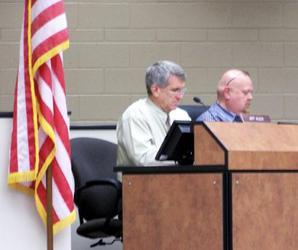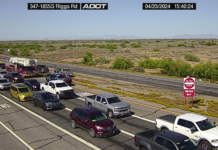
The primary focus for Maricopa Unified School District’s governing board Wednesday evening was the Nov. 2 override election, and information both staff and community members need to know about it.
Business director Aron Rausch presented the facts regarding the override, its history and both revenue and deficits affecting the district’s overall budgetary future.
Originally passed on May 17, 2005, override funding, if not renewed, will be reduced by a third this year, two thirds next year and will expire the third year. This is a 6.67 percent initiative, which means that homeowners pay $84.17 per $100,000 of assessed valuation (assessed valuation is down 20-23 percent). That amount can be written off state taxes, leaving an actual homeowner contribution of about $4 per month. Renters would pay nothing.
If passed, the override would generate $1,934,300 in district revenues annually for the next five years, bringing in a total of $9,671,500.
“The board kept its promise to keep the rate low enough to ask for, but not too much,” said Superintendent Jeff Kleck.
Why the need for an override? According to Kleck, “It’s not so much about adding staff, curriculum and things like that. It’s more to help try to stabilize, and to keep the ship from tipping.”
The district currently has 6,019 students, down 400 from last year, which is a loss of $1.3 million. The high school’s numbers are up (1650 approximately), but not those at other schools.
“I think we’re experiencing some of the things Mesa is experiencing,” Kleck said. “I know we had folks bailing out during budget discussions this summer, and some young families have had to bail out on homes. It’s the same in Kyrene and Tempe as well.”
Fewer students equal less money from the state, which bases funding on average daily attendance, but special education is funded at only 17 percent; costs over that come from the regular student education budget. Arizona’s state deficit is $1 billion for 2011 and $700,000 for this year (depending on the Nov.2 election), according to Rausch.
Census monies will not be available until the 2011-2012 school year, and the Ak-Chin grant is only for two years and for specific positions. It will end in 2011-2012. The state, which has cut $1 million each year in education funding, will also withhold dollars from the federal jobs act allocation.
Utility costs are on the increase, and funds are not available for the district to acquire new technology or to purchase new textbooks, typically purchased on a subject matter cycle. “The state keeps updating AIMS standards, however,” said board member Tracy Davis. Because textbooks do not correlate with all the new standards, teachers must find supplemental materials.
“We may need to cut next year’s budget by $2-3.5 million, depending on the legislature,” Rausch explained.
“We took a huge hit this year, and what bothers me is that the public doesn’t know that we’re not the only ones (school districts). Administrators are doing one, two or three jobs; staff can’t take much more, and we’ll lose good people,” said board member Carrie Vargas.
“How many teachers or administrators can we afford to lose?” asked board president Geoff Goddard. “We’re thin already.” Currently there are 30 district administrators, including school sites and the district office.
“That’s my kids and your kids going to those schools,” said board member Tim White, regarding the proposed override. “The bottom line is we have to step up.”
Rausch, Kleck and Human Resource Director Tom Beckett will be bringing override information to every school’s staff. They began with Pima Butte Elementary on Wednesday. Override election pamphlets are available at the district office, at schools and on the district website. To view the information, click here.
The last day to register to vote in the Nov. 2 election is Oct. 4; Oct. 22 is the last day to request an early ballot.
Photo by Joyce Hollis





![Maricopa’s ‘TikTok Rizz Party,’ explained One of several flyers for a "TikTok rizz party" is taped to a door in the Maricopa Business Center along Honeycutt Road on April 23, 2024. [Monica D. Spencer]](https://www.inmaricopa.com/wp-content/uploads/2024/04/spencer-042324-tiktok-rizz-party-flyer-web-218x150.jpg)







![Alleged car thief released without charges Phoenix police stop a stolen vehicle on April 20, 2024. [Facebook]](https://www.inmaricopa.com/wp-content/uploads/2024/04/IMG_5040-218x150.jpg)



